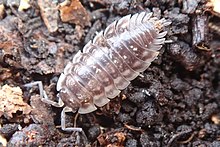|
Oniscus asellus
Oniscus asellus, the common woodlouse, or common shiny woodlouse[2] is one of the largest and most common species of woodlouse native to the British Isles and Western and Northern Europe, growing to lengths of 16 mm and widths of 6 mm. DistributionThe common woodlouse is the most widespread species of woodlouse in the British Isles, both geographically and ecologically.[3] It is rare in the Mediterranean Basin, but is widespread in Northern and Western Europe, as far east as Ukraine, as well as in the Azores and Madeira; it has also been widely introduced in the Americas,[1] predominantly in Mexico and in the United States, east of the Mississippi River and west of the Rocky Mountains.[2]  EcologyThe common woodlouse occurs in a wide range of habitats, including some with little available calcium. It is chiefly found under stones, and on rotting wood.[3] It is the only woodlouse regularly found on heather moors and blanket bogs, where it lives around items such as rotting fenceposts.[3] DescriptionThe common woodlouse is one of the largest native woodlice in Britain, at up to 16 mm (0.63 in) long.[4] It is relatively flat, and is a shiny brown/grey in colour,[3] although juveniles are rougher.[4]  Pale patches are often visible on the back of Oniscus asellus; these are areas that store calcium, which is then used to reinforce the exoskeleton after a moult.[4] Moulting occurs in two halves, with the rear half moulting before the front half. The exuvia (the thing that is being moulted) is often consumed by the animal after moulting.[4] See alsoReferences
External links
|
||||||||||||||||||||||||||||||||
